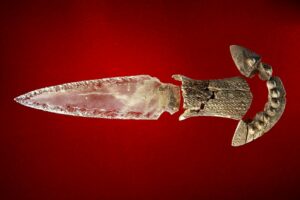Mike The Headless Chicken, who lived for 18 months after its head was chopped off.

On September 10, 1945, the owner Lloyd Olsen from Fruita, Colorado was planning to eat Mike in their supper. Eventually, his axe removed the bulk of its head, but missed the jugular vein, leaving one ear and most of the brain stemintact, and Mike was still able to balance on a perch and walk clumsily. When Mike did not die, Olsen instead decided to care for the bird. He fed it a mixture of milk and water via an eyedropper, and gave small grains of corn. Days turned into months and Mike continued to live healthy without his head.
Once his fame had been established, Mike began a career of touring sideshows in the company of such other anomalies as a two-headed baby. He was also photographed for dozens of magazines and papers, and was featured in Time and Life magazines. Mike was put on display to the public for an admission cost of 25 cents. At the height of his popularity, the chicken’s owner earned US$4,500 per month ― equivalent to $52,000 in 2020. Mike was valued at $10,000 ― equivalent to $115,000 in 2020.
On March 17, 1947, at a motel in Phoenix on a stopover while traveling back from tour, Mike started choking in the middle of the night. He had managed to get a kernel of corn in his throat. The Olsens had inadvertently left their feeding and cleaning syringes at the sideshow the day before, and so were unable to save Mike. Olsen claimed that he had sold the bird off, resulting in stories of Mike still touring the country as late as 1949. Other sources say that the chicken’s severed trachea could not properly take in enough air to be able to breathe, and it therefore choked to death in the motel.
It was determined that the axe had missed the jugular vein and a clot had prevented Mike from bleeding to death. Although most of his head was severed, most of his brain stem and one ear were left on his body. Since basic functions such as breathing, heart rate, etc. as well as most of a chicken’s reflex actions are controlled by the brain stem, Mike was able to remain quite healthy. This is a good example of central motor generators enabling basic homeostatic functions to be carried out in the absence of higher brain centres.
In addition, birds possess a secondary balance organ in the pelvic region, the lumbosacral organ, which controls walking locomotion virtually independently from the vestibular organ involved in flight. This has been used to explain how a headless chicken can walk and balance, despite the destruction of much of the cranial vestibular system.




